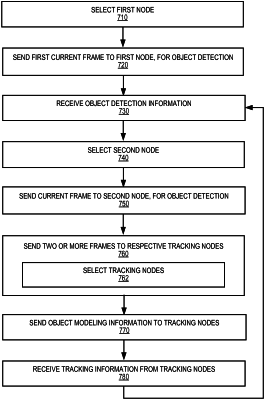| CPC G06T 7/248 (2017.01) [G06V 20/40 (2022.01); G06T 2207/10016 (2013.01)] | 20 Claims |

|
1. A method for tracking a location of an object in a series of frames of a video stream, the method comprising:
selecting, from a set of two or more nodes available for object detection, a first node;
sending a first current frame from the series of frames to the first node, for detection of a first object in the frame;
receiving, from the first node, object detection information for the first object;
subsequently to receiving the object detection information for the first object from the first node:
selecting, from the set of two or more nodes available for object detection, a second node, and sending a second current frame from the series of frames to the second node, for an updated detection of the first object;
sending each of two or more frames following the second current frame to respective tracking nodes for tracking of the first object by the respective tracking nodes, wherein sending each frame to a respective tracking node comprises selecting the respective tracking node from a set of two or more nodes available for tracking and wherein each of the two or more frames is sent to only the selected respective tracking node from among the set;
sending object modelling information indicating location and/or classification of one or more objects derived from the object detection information to each of the respective tracking nodes; and
receiving, from each of the respective tracking nodes, tracking information for the first object for the frame sent to the respective tracking node.
|